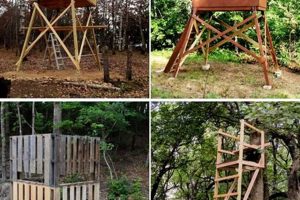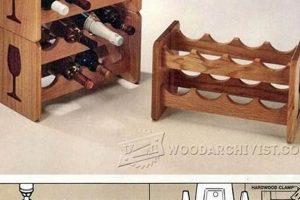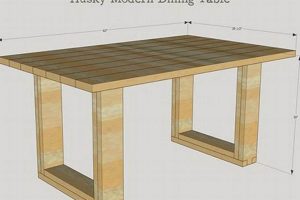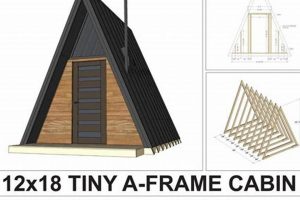Instructions detailing the construction of outdoor seating and tables, intended for assembly by the end-user, fall under the category of do-it-yourself outdoor furniture blueprints. These guides typically encompass material lists, dimensional diagrams, and step-by-step assembly procedures. A typical example includes instructions for building a combined table and seating structure designed for outdoor dining.
The appeal of these projects lies in their cost-effectiveness and the potential for customization. Individuals can tailor the size, style, and materials used to match specific aesthetic preferences and spatial constraints. Historically, creating one’s own furnishings was a necessity for many; today, it represents a blend of practicality and personal expression, offering a tangible connection to the construction process.
The subsequent sections will explore the various design options available, the essential tools and materials required, and the recommended safety precautions necessary for successful project completion. Considerations regarding material selection for longevity and weather resistance will also be addressed.
Construction Insights for Outdoor Seating and Table Projects
The following guidelines aim to enhance the execution and longevity of self-assembled outdoor furniture projects. Careful adherence to these points will contribute to a structurally sound and aesthetically pleasing final product.
Tip 1: Material Selection is Paramount: Opt for lumber treated for outdoor use, such as pressure-treated pine or naturally weather-resistant species like cedar or redwood. This will mitigate rot, insect infestation, and warping due to environmental exposure.
Tip 2: Prioritize Accurate Measurements and Cuts: Precise dimensions are crucial for structural integrity and aesthetic appeal. Employ a measuring tape, carpenter’s square, and saw with appropriate blade for clean, accurate cuts.
Tip 3: Secure Fasteners are Essential: Utilize exterior-grade screws or bolts specifically designed for outdoor applications. These fasteners resist corrosion and provide a robust connection between components.
Tip 4: Apply Protective Finishes: After assembly, apply a sealant, stain, or paint formulated for exterior use. This layer provides an additional barrier against moisture, UV radiation, and other environmental factors.
Tip 5: Ensure Proper Support and Stability: Reinforce joints with metal brackets or additional lumber supports to prevent sagging or wobbling. Consider the weight-bearing capacity of the structure during design and construction.
Tip 6: Pay Attention to Ergonomics: Consider the seat height, table height, and legroom dimensions to ensure comfortable seating and dining. Test the design with intended users to identify potential ergonomic issues.
Tip 7: Sand All Surfaces Smooth: Sanding all surfaces, especially edges and corners, before finishing prevents splinters and enhances the overall appearance and tactile feel of the finished piece.
These insights are provided to facilitate a successful and enduring outcome when undertaking the construction of outdoor seating and table combinations. Diligent application of these principles contributes to a product that is both functional and visually appealing.
The subsequent section will address common challenges encountered during such projects and propose effective troubleshooting strategies.
1. Material Selection
Material selection represents a critical juncture in the execution of outdoor seating and table construction. The choice of materials directly influences the structural integrity, longevity, and aesthetic appeal of the finished product. Careful consideration is paramount to ensure the project withstands environmental factors and meets desired performance criteria.
- Weather Resistance
Wood’s inherent susceptibility to moisture and decay necessitates careful consideration of species and treatments. Untreated lumber rapidly deteriorates when exposed to the elements. Pressure-treated pine and naturally resistant woods like cedar and redwood offer enhanced protection. Choosing appropriate wood can drastically extend the lifespan of the structure, mitigating the need for frequent repairs or replacement.
- Structural Integrity
The load-bearing capacity of the material selected directly impacts the stability and safety of the seating and table combination. Softer woods may not be suitable for larger structures or areas with high usage. Dense hardwoods or reinforced composites provide greater resistance to bending and breakage, ensuring the structural integrity of the design. The appropriate lumber must withstand intended use.
- Cost and Availability
Material costs can significantly influence the overall budget of the project. While premium lumber offers superior performance, more economical options may suffice for smaller or less frequently used structures. The accessibility of specific materials within the local market must also be considered. Balancing cost with desired performance characteristics is essential.
- Aesthetic Considerations
The visual appearance of the chosen material contributes significantly to the overall aesthetic appeal of the finished product. Different wood species exhibit varying grain patterns, colors, and textures. The selected material should complement the surrounding environment and align with the desired aesthetic style. Coatings and finishes can further enhance the visual appeal and provide added protection.
The foregoing facets underscore the vital role of material selection in self-assembled outdoor seating and table creations. A holistic approach, encompassing weather resistance, structural demands, budgetary limitations, and aesthetic preferences, is crucial for achieving a successful and enduring outcome. Poor material choices inevitably lead to premature deterioration, compromised safety, and diminished aesthetic value.
2. Accurate Measurements
Precise dimensional control constitutes a foundational element in the successful execution of self-assembled outdoor seating and table projects. The fidelity with which measurements are translated into physical cuts and assemblies directly impacts the structural integrity, aesthetic harmony, and overall functionality of the finished product. Deviation from specified dimensions invites instability, misalignment, and compromised load-bearing capacity.
- Structural Stability and Load Distribution
Accurate measurements ensure proper alignment of structural components, facilitating the even distribution of weight and stress across the entire framework. Dimensional discrepancies can create stress concentration points, leading to premature failure of joints or individual members. A precisely dimensioned leg assembly, for example, guarantees uniform support, preventing uneven settling or collapse under load.
- Joint Integrity and Secure Fastening
Precise measurements are crucial for creating tight-fitting joints that can be securely fastened. Gaps or misalignments resulting from inaccurate cuts compromise the strength of the joint and reduce the effectiveness of fasteners. For instance, a tenon that is too small for its mortise, due to inaccurate measurement, will result in a weak and unstable connection, regardless of the type of fastener employed. Precise measurements lead to durable structural joints.
- Aesthetic Harmony and Visual Appeal
Accurate measurements contribute to the overall visual appeal of the finished product by ensuring symmetry, proportionality, and a clean, professional appearance. Dimensional inconsistencies can create visual distractions and detract from the intended aesthetic design. Ensuring that all components are accurately measured will avoid any visual anomalies.
- Material Efficiency and Cost Control
Precise measurements minimize material waste by reducing the likelihood of errors and miscuts. Accurate planning and cutting techniques allow for the efficient utilization of lumber, reducing overall project costs and minimizing environmental impact. Accurate planning minimizes wasted material.
The aforementioned considerations underscore the indispensable role of accurate measurements in the creation of durable, aesthetically pleasing, and structurally sound outdoor seating and table combinations. A diligent approach to dimensional control, employing precise measuring tools and careful cutting techniques, is essential for realizing a successful and long-lasting project.
3. Secure Fastening
Secure fastening is a critical determinant of the structural integrity and longevity of self-assembled outdoor furniture projects. The methods and materials used to join components directly influence the load-bearing capacity, stability, and resistance to environmental stressors of the finished product. Inadequate fastening techniques result in weakened joints, premature failure, and potential safety hazards. Projects involving combined seating and tables demand meticulous attention to secure connections to ensure both utility and safety.
The selection of appropriate fasteners is paramount. Exterior-grade screws, bolts, and specialized connectors designed for outdoor use are essential to resist corrosion and maintain structural integrity over time. For instance, using uncoated interior screws in an outdoor setting will result in rapid rust and subsequent joint failure. Real-world examples of picnic benches collapsing due to corroded fasteners underscore the practical significance of this consideration. The type of wood utilized also affects fastener choice; hardwoods require pre-drilling to prevent splitting, while softer woods necessitate fasteners with greater holding power.
Effective secure fastening encompasses not only the selection of appropriate materials but also the correct application of joining techniques. Proper torque on bolts, countersinking screws to prevent water ingress, and utilizing adhesives in conjunction with mechanical fasteners enhance the overall strength and durability of connections. Understanding the principles of wood joinery and applying them correctly contribute significantly to the success of any outdoor seating or table project. In summary, the combination of appropriate materials and techniques ensures a safe and lasting finished product.
4. Protective Finishes
The application of protective finishes to self-assembled outdoor seating and table projects represents a crucial step in ensuring longevity and aesthetic preservation. These treatments shield the underlying material from environmental degradation, thereby extending the service life of the structure and maintaining its visual appeal.
- Moisture Resistance
Protective coatings, such as sealants and waterproof stains, impede the absorption of moisture into the wood. This barrier prevents swelling, warping, and rot, common causes of deterioration in outdoor furniture. Unprotected wood will absorb atmospheric moisture, leading to expansion and contraction cycles that weaken joints and promote fungal growth. Effective moisture resistance ensures long-term structural integrity.
- Ultraviolet (UV) Protection
Exposure to ultraviolet radiation from sunlight degrades the lignin in wood, causing discoloration, surface cracking, and weakening of the material. Finishes containing UV inhibitors mitigate this damage by absorbing or reflecting harmful rays. Failure to provide UV protection results in a graying and brittle surface, reducing the lifespan and aesthetic value of the picnic bench.
- Pest Deterrence
Certain protective finishes incorporate insecticides or create a physical barrier against wood-boring insects. These treatments protect the wood from infestation by termites, carpenter ants, and other pests that can compromise the structural integrity of the furniture. Protecting against pests can maintain the product for a longer time.
- Aesthetic Enhancement
Protective finishes also serve to enhance the aesthetic appeal of the wood. Stains can alter the color and highlight the grain, while clear coatings provide a glossy or matte finish. The choice of finish allows for customization and coordination with the surrounding environment, contributing to the overall visual impact of the outdoor space. The finish of a product can change depending on the aesthetic that is wanted.
The integration of appropriate protective finishes represents a cost-effective measure to safeguard self-assembled picnic benches from the ravages of weather, pests, and ultraviolet radiation. Careful selection and application of these treatments contribute significantly to the long-term durability, functionality, and visual appeal of these outdoor structures.
5. Ergonomic Design
Ergonomic design, when integrated into DIY picnic bench plans, directly influences user comfort, posture, and overall satisfaction. The absence of ergonomic considerations can lead to discomfort, strain, and potentially long-term health issues. The seat height, table height, and back support angles, when improperly designed, can force users into awkward postures, increasing the risk of back pain, neck strain, and leg discomfort. The inclusion of ergonomic principles transforms a simple structure into a functional and comfortable amenity.
Specifically, plans should specify a seat height that allows users to place their feet flat on the ground, promoting proper leg circulation and reducing pressure on the lower back. Table height should facilitate easy reach for dining and conversation, minimizing hunching and promoting a neutral spine alignment. Backrests, when incorporated, must provide adequate lumbar support, preventing slouching and reducing the risk of back pain. Real-world examples include picnic benches with overly low seats, forcing users to sit with their knees higher than their hips, leading to lower back strain. Conversely, benches with properly angled backrests allow users to sit comfortably for extended periods, promoting relaxation and enjoyment.
The understanding and application of ergonomic principles are therefore crucial for successful DIY picnic bench projects. Addressing these considerations early in the design phase ensures that the finished product is not only aesthetically pleasing and structurally sound but also conducive to user well-being. Neglecting ergonomic aspects can render the bench unusable for extended periods, negating the purpose of the project. Effective plans integrate ergonomic features, thereby enhancing the utility and value of the structure.
6. Structural Stability
Structural stability, in the context of do-it-yourself outdoor seating and table blueprints, represents the capacity of the constructed piece to withstand applied loads and maintain its intended geometry without undergoing excessive deformation or catastrophic failure. Ensuring sufficient structural stability is paramount for safety and longevity.
- Joint Integrity
The strength and rigidity of connections between individual components directly influence overall stability. Weak or improperly executed joints compromise the load-bearing capacity of the structure. For example, inadequate fastening of legs to the table surface can lead to wobbling or collapse under weight. Proper joinery techniques and robust fasteners are essential for mitigating these risks. Dovetail joints are much more stable than a simple screw together connection.
- Material Selection and Load Capacity
The choice of materials and their respective dimensions must align with the anticipated loads. Using undersized lumber or materials with insufficient strength characteristics compromises structural integrity. For instance, employing thin pine boards for a heavy-duty table surface will likely result in sagging or cracking over time. A structural calculation is necessary to confirm stability of the picnic bench.
- Bracing and Reinforcement
The strategic incorporation of bracing elements enhances stability by distributing loads and preventing racking or twisting. Cross-braces, gussets, and diagonal supports provide additional resistance to deformation under stress. In the absence of adequate bracing, the structure may become unstable, particularly when subjected to uneven loading or external forces such as wind. Bracing increases stability.
- Foundation and Support Conditions
The stability of a table and seating combination is inherently linked to the underlying support conditions. Uneven or unstable ground surfaces introduce stresses and increase the risk of tipping or collapse. Ensuring a level and firm foundation is crucial for maintaining structural integrity, particularly in outdoor environments where soil conditions may vary. A sturdy ground is a necessity for structural support.
The successful execution of do-it-yourself outdoor seating and table endeavors hinges on a comprehensive understanding of structural stability principles. Addressing joint integrity, material selection, bracing techniques, and foundation requirements contributes to a safe, durable, and aesthetically pleasing finished product.
Frequently Asked Questions
The following questions address common inquiries and misconceptions concerning the construction of picnic benches from self-assembly blueprints. The information provided aims to offer clarity and guidance for prospective builders.
Question 1: What constitutes essential safety precautions when undertaking such projects?
Adherence to fundamental safety protocols is paramount. Eye protection, hearing protection, and appropriate work gloves are mandatory. The safe operation of power tools requires thorough familiarity with manufacturer guidelines. A well-ventilated workspace is critical to mitigate exposure to dust and fumes. The use of appropriate respiratory equipment may be warranted depending on materials and processes involved.
Question 2: What wood types are optimally suited for outdoor use?
Species exhibiting natural resistance to decay and insect infestation are preferable. Cedar, redwood, and pressure-treated pine represent viable options. Untreated softwoods necessitate protective coatings to prevent premature deterioration. The selection should consider regional climate conditions and anticipated exposure levels.
Question 3: What fastener types are recommended for joint construction?
Exterior-grade screws, bolts, and connectors specifically designed for outdoor applications are required. Galvanized or stainless-steel fasteners are recommended to prevent corrosion and maintain structural integrity over time. The fastener length and diameter must align with the thickness and density of the materials being joined.
Question 4: How should the longevity of the finished product be ensured?
Regular maintenance is essential. Periodic inspection for signs of decay, insect damage, or loose fasteners is recommended. Reapplication of protective coatings, such as sealants or stains, may be necessary to maintain moisture resistance and ultraviolet protection. Prompt repair of any identified issues will prevent further deterioration.
Question 5: Are specialized tools required for construction?
While basic hand tools are sufficient for simple designs, power tools enhance efficiency and precision. A circular saw, drill, and sander are commonly employed. Specialized tools, such as a router or jointer, may be necessary for more complex joinery techniques. Invest in quality tools.
Question 6: How does one account for variations in terrain when designing or constructing the seating?
Adjustable feet or shims can compensate for uneven ground surfaces. Careful measurement of the terrain is essential to ensure that the seating remains level and stable. Consider anchoring the structure to the ground to prevent tipping or displacement, particularly in windy areas.
These FAQs provide a baseline understanding of key considerations. Diligent planning and execution are crucial for a successful outcome.
The subsequent section will detail specific design considerations for seating and dining.
Concluding Considerations for DIY Picnic Bench Plans
This exploration of the topic has underscored several critical facets for successful execution. Material selection, accurate measurements, secure fastening, protective finishes, ergonomic design, and structural stability are all interdependent elements that contribute to a durable and functional outcome. Careful consideration of these factors will result in a seating and table combination that withstands environmental stressors and provides lasting utility.
The construction, while offering potential cost savings and customization options, demands meticulous planning and adherence to safety protocols. It’s more than a simple project; it embodies the application of sound engineering and design principles. A thorough understanding of these principles, coupled with diligent execution, will yield a valuable asset that can enhance outdoor spaces for years to come. Neglecting these principles risks premature failure and potential safety hazards.







